Spatiotemporal Distribution of Irrigation Water Use Efficiency from the Perspective of Water Footprints in Heilongjiang Province
Abstract
:1. Introduction
2. Materials and Methods
2.1. Overview of the Study Area
2.2. Data Sources
2.3. Water Footprint Theory
2.3.1. Grain Water Footprint
2.3.2. Grain Gray Water Footprint
2.4. SBM-DEA Model
3. Results
3.1. Analysis of the Grain Water Footprint in Heilongjiang Province
Temporal Distribution
3.2. Evaluation of Irrigation Water Use Efficiency in Heilongjiang Province
3.2.1. Spatial Distribution
3.2.2. Analysis of Underdeveloped Regions
4. Discussion
4.1. Suggestions on Sustainable Development of Grain Water in Heilongjiang Province
4.2. Relationship between Irrigation Water Use Efficiency and Socio-Economic Factors
4.3. Future Research
5. Conclusions
- (1)
- In view of the timeline, the irrigation water use efficiency of Heilongjiang Province showed a steady and slow downward trend from 2008 to 2018 with an average irrigation water efficiency of 0.821; this level did not reach the effective state. Large gaps were found in irrigation water use efficiency among different regions from 2008 to 2015, and the gap in the regional irrigation water use efficiency gradually narrowed from 2016 to 2018.
- (2)
- In view of the spatial distribution, significant differences were found in the irrigation water use efficiencies in different regions of Heilongjiang Province, showing the overall distribution pattern of west > south > east > north. Harbin, Qiqihar and Jixi had high-level irrigation water use efficiencies among the whole province; Jiamusi, Hegang, Shuangyashan, Yichun and Mudanjiang had second-level irrigation water use efficiencies that did not reach the provincial-level average.
- (3)
- At the second level, the pure technical efficiency was greater than the scale efficiency in Jiamusi and Hegang. The pure technical efficiency and scale efficiency in Shuangyashan were both close to the corresponding average levels of the whole province. The pure technical efficiency and scale efficiency were close to 1 in Yichun. In Mudanjiang, the pure technical efficiency was less than the scale efficiency only in 2018. The irrigation water use efficiency mainly depends on the pure technical efficiency. We should learn from the regions with advanced technology and gradually improve the technical level throughout the province.
- (4)
- To address the problems associated with agricultural water use in Heilongjiang Province, on the one hand, we should strengthen interregional cooperation and government macrocontrol, optimize the agricultural production planting structure according to regional characteristics, and improve the water and land resource allocation efficiencies. Additionally, we should actively develop agricultural science and technology research, optimize the agricultural water use mode, and increase investment in agricultural technologies and water conservancy construction in irrigated areas to improve the irrigation water use efficiency by enhancing the pure technical efficiency.
Author Contributions
Funding
Institutional Review Board Statement
Informed Consent Statement
Data Availability Statement
Conflicts of Interest
References
- Li, M.; Fu, Q.; Singh, V.P.; Liu, D.; Li, T.; Zhou, Y. Managing agricultural water and land resources with tradeoff between economic, environmental, and social consideration: A multi-objective non-linear optimization model under uncertainty. Agric. Syst. 2020, 178, 102685. [Google Scholar] [CrossRef]
- Fu, Q.; Liu, W.; Liu, D.; Li, T. Spatial Distribution of Irrigation Water Use Efficiency Index System in Heilongjiang Province. Trans. Chin. Soc. Agric. Mach. 2015, 46, 127–132. [Google Scholar]
- Nie, T.; Jiao, Y.; Tang, Y.; Li, N.; Wang, T.; Du, C.; Zhang, Z.; Li, T.; Zhu, S.; Sun, Z.; et al. Study on the Water Supply and the Requirements, Yield, and Water Use Efficiency of Maize in Heilongjiang Province Based on the AquaCrop Model. Water 2021, 13, 2665. [Google Scholar] [CrossRef]
- Shao, D.; He, S.; Li, H. A New Index and Its Evaluation Method for the District Water Efficiency. J. Irrig. Drain. 2015, 34, 9–12, 32. [Google Scholar] [CrossRef]
- Cao, X.; Cui, S.; Wu, M.; Ren, J.; Guo, X. Comprehensive evaluation of water resources utilization efficiency of rice fields under the framework of water footprint. J. Hydraul. Eng. 2020, 51, 1189–1198. [Google Scholar]
- Zhou, X.; Luo, R.; Yao, L.; Cao, S.; Wang, S.; Lev, B. Assessing integrated water use and wastewater treatment systems in China: A mixed network structure two-stage SBM DEA model. J. Clean. Prod. 2018, 185, 533–546. [Google Scholar] [CrossRef]
- Lei, G.; Hu, Z.; Han, G. Research on technical efficiency and water-saving potential of agricultural water use based on SFA. Water Conserv. Econ. 2010, 28, 55–58. [Google Scholar]
- Pereira, H.; Marques, R.C. An analytical review of irrigation efficiency measured using deterministic and stochastic models. Agric. Water Manag. 2017, 184, 28–35. [Google Scholar] [CrossRef]
- Sun, F.; Chen, R.; Zhang, Z. Evaluation of utilization efficiency of regional agricultural water resources based on three-stage DEA Malmquist model. J. Econ. Water Resour. 2019, 37, 53–58, 78, 87–88. [Google Scholar]
- Choi, K.H.; Cho, J.K. Case Study on the Jeollabuk-do Local Water Supply Efficiency by using DEA and Malmquist Index. J. Digit. Converg. 2014, 12, 571–580. [Google Scholar] [CrossRef] [Green Version]
- Palomero-González, J.A.; Almenar-Llongo, V.; Fuentes-Pascual, R. Evaluating the Efficiency of Water Distribution Net-work Sectors Using the DEA-Weight Russell Directional Distance Model: The Case of the City of Valencia (Spain). Sustainability 2021, 13, 10546. [Google Scholar] [CrossRef]
- Liu, W.; Li, Y.; Fu, Q.; Meng, J.; Li, T.; Dai, S. Spatial and Temporal Distributions of Crop Water Footprint and Its Influence Factors Analysis in Heilongjiang Province. Trans. Chin. Soc. Agric. Mach. 2020, 51, 214–222, 335. [Google Scholar]
- Tong, G. Research on the Promotion of Comprehensive Grain Production Capacity in the Main Grain Producing Areas of Commodity Grain Heilongjiang Province; Northeast Forestry University: Harbin, China, 2020. [Google Scholar]
- Liu, W. Research on the Temporal and Spatial Differentiation of Irrigation Water Use Efficiency and Water Saving Potential in Heilongjiang Province; Northeast Agricultural University: Harbin, China, 2017. [Google Scholar]
- Fu, Q.; Liu, W.; Liu, D.; Li, T. Fractal Characteristics and Influence Factors Analysis of Irrigation Water Use Efficiency in Heilongjiang Province. Trans. Chin. Soc. Agric. Mach. 2016, 47, 147–153. [Google Scholar]
- Liu, Y. Analysis of Temporal and Spatial Distribution and Influencing Factors of Water Productivity of Grain Crops in Heilongjiang Province; Northeast Agricultural University: Harbin, China, 2017. [Google Scholar]
- Fu, Q.; Liu, Y.; Li, T.; Cui, S.; Liu, D.; Cheng, K. Water footprint analysis of grain production in Heilongjiang Province from the perspective of water footprint. Trans. Chin. Soc. Agric. Mach. 2017, 48, 184–192. [Google Scholar]
- Hoekstra, A.Y.; Chapagain, A.K.; Mekonnen, M.M.; Aldaya, M.M. The Water Footprint Assessment Manual: Setting the Global Standard; Esrthscan: London, UK, 2011. [Google Scholar]
- Food and Agriculture Organization of the United Nations. CROPWAT: A Computer Program for Irrigation Planning and Management; Food and Agriculture Organization of the United Nations: Rome, Italy, 1992; pp. 20–21. [Google Scholar]
- Huang, K.; Wang, Z.; Yang, S.; Jin, C. Theory, calculation method and application progress of water footprint. Adv. Sci. Technol. Water Resour. 2013, 33, 78–83. [Google Scholar]
- Fu, T.; Xu, C.; Yang, L.; Hou, S.; Xia, Q. Measurement and driving factors of grey water footprint efficiency in Yangtze River Basin. Sci. Total Environ. 2022, 802, 149587. [Google Scholar] [CrossRef]
- Cao, L.; Wu, P.; Zhao, X.; Wang, Y. Grey Water Footprint Evaluation of Grain Production in Hetao Irrigation District of Inner Mongolia. Trans. Chin. Soc. Agric. Eng. 2014, 30, 63–72. [Google Scholar]
- Ying, Z.; Zhao, H.; Wang, F.; Zhang, H.; Ma, S. Evaluation of Water Resources Utilization Efficiency and Influencing Factors in Henan Province Based on DEA and Tobit Models. South-North Water Divers. Water Conserv. Sci. Technol. 2021, 19, 255–262. [Google Scholar]
- Liang, J.; Zhang, A.; Li, C. An Empirical Study on Agricultural Irrigation Water Efficiency Based on Weight Constraint DEA and Tobit Model-Taking Heilongjiang Province as an Example. Water Sav. Irrig. 2018, 4, 62–68. [Google Scholar] [CrossRef]
- He, J. Research on the Operating Efficiency of My Country’s Commercial Banks Based on DEA Method; Southwestern University of Finance and Economics: Chengdu, China, 2014. [Google Scholar]
- Sun, S.K.; Wang, Y.B.; Liu, J.; Wu, P.T. Quantification and evaluation of water footprint of major grain crops in China. J. Hydraul. Eng. 2016, 47, 1115–1124. [Google Scholar]
- Tan, Z.; Guo, X. Evaluation and Analysis of Chinese Grain Production Water Use Efficiency Based on Super-efficiency DEA Model. Trans. Chin. Soc. Agric. Mach. 2019, 50, 280–288. [Google Scholar]
- Lilienfeld, A.; Asmild, M. Estimation of excess water use in irrigated agriculture: A Data Envelopment Analysis approach. Agric. Water Manag. 2007, 94, 73–82. [Google Scholar] [CrossRef]
- Yilmaz, B.; Yurdusev, M.A.; Harmancioglu, N.B. The Assessment of Irrigation Efficiency in Buyuk Menderes Basin. Water Resour. Manag. 2009, 23, 1081–1095. [Google Scholar] [CrossRef]
- Ma, W.; Meng, L.; Wei, F.; Opp, C.; Yang, D. Spatiotemporal variations of agricultural water footprint and socioeconomic matching evaluation from the perspective of ecological function zone. Agric. Water Manag. 2021, 249, 106803. [Google Scholar] [CrossRef]
- Tan, Z.; Guo, X. Evaluation and analysis of China’s grain production efficiency: Based on the super efficiency DEA model. Res. Agric. Mod. 2019, 40, 431–440. [Google Scholar]
- Li, M.; Fu, Q.; Singh, V.P.; Liu, D.; Gong, X. Risk-based agricultural water allocation under multiple uncertainties. Agric. Water Manag. 2020, 233, 106105. [Google Scholar] [CrossRef]
- Li, M.; Cao, X.; Liu, D.; Fu, Q.; Li, T.; Shang, R. Sustainable management of agricultural water and land resources under changing climate and socio-economic conditions: A multi-dimensional optimization approach. Agric. Water Manag. 2022, 259, 107235. [Google Scholar] [CrossRef]
- Deng, Y. Countermeasures to the evolution trend of chemical fertilizer utilization in Heilongjiang Province. China For. Econ. 2016, 42–45. [Google Scholar] [CrossRef]
- Shang, S.; Jiang, L.; Yang, Y. Research progress of irrigation water efficiency evaluation methods based on remote sensing. Trans. Chin. Soc. Agric. Mach. 2015, 46, 81–92. [Google Scholar]
- Li, T.; Fu, Q.; Meng, F.; Cui, S.; Liu, D. Study on precipitation trend and its impact on agricultural production in Heilongjiang Province. J. Irrig. Drain. 2017, 36, 103–108. [Google Scholar]
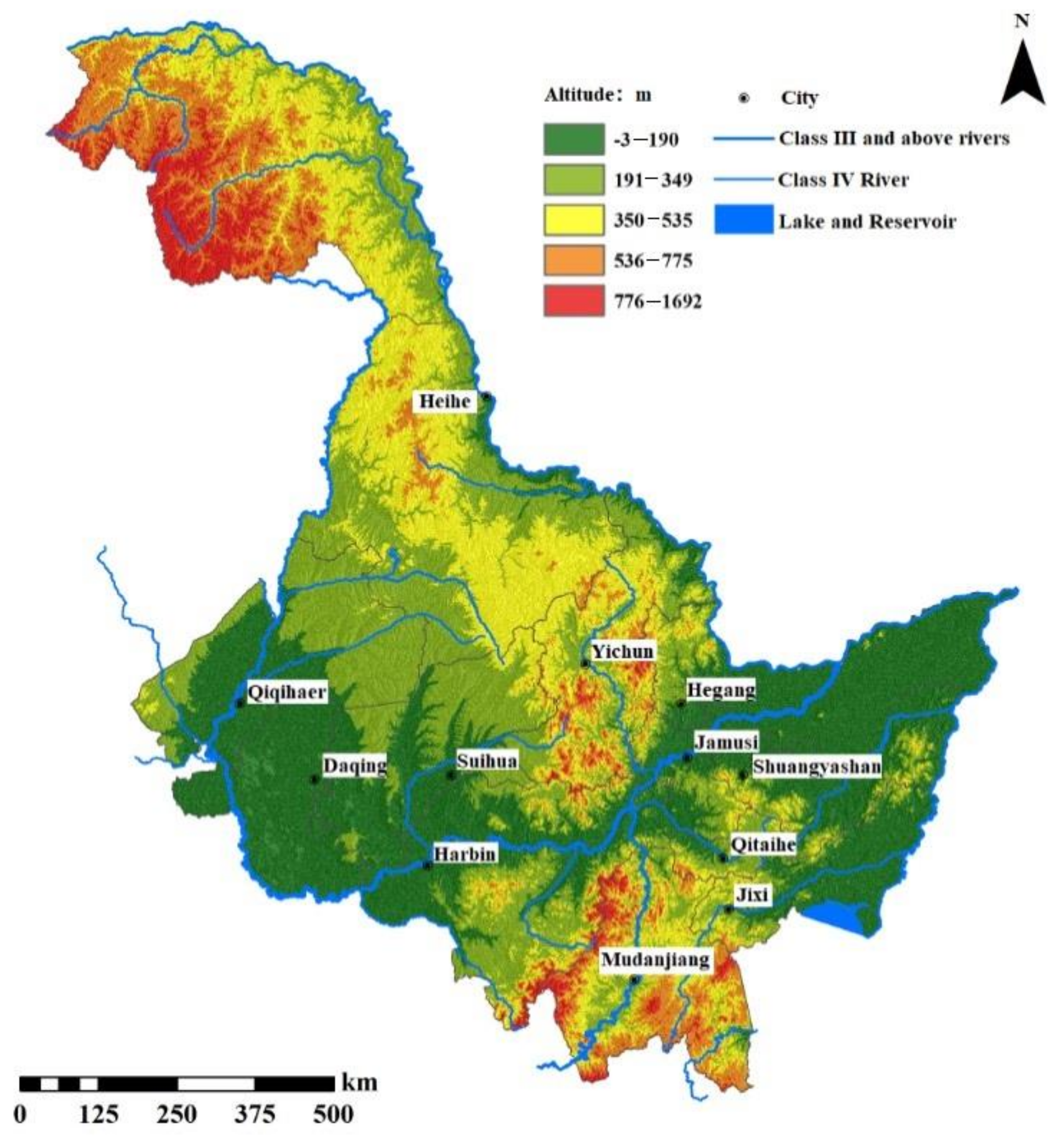
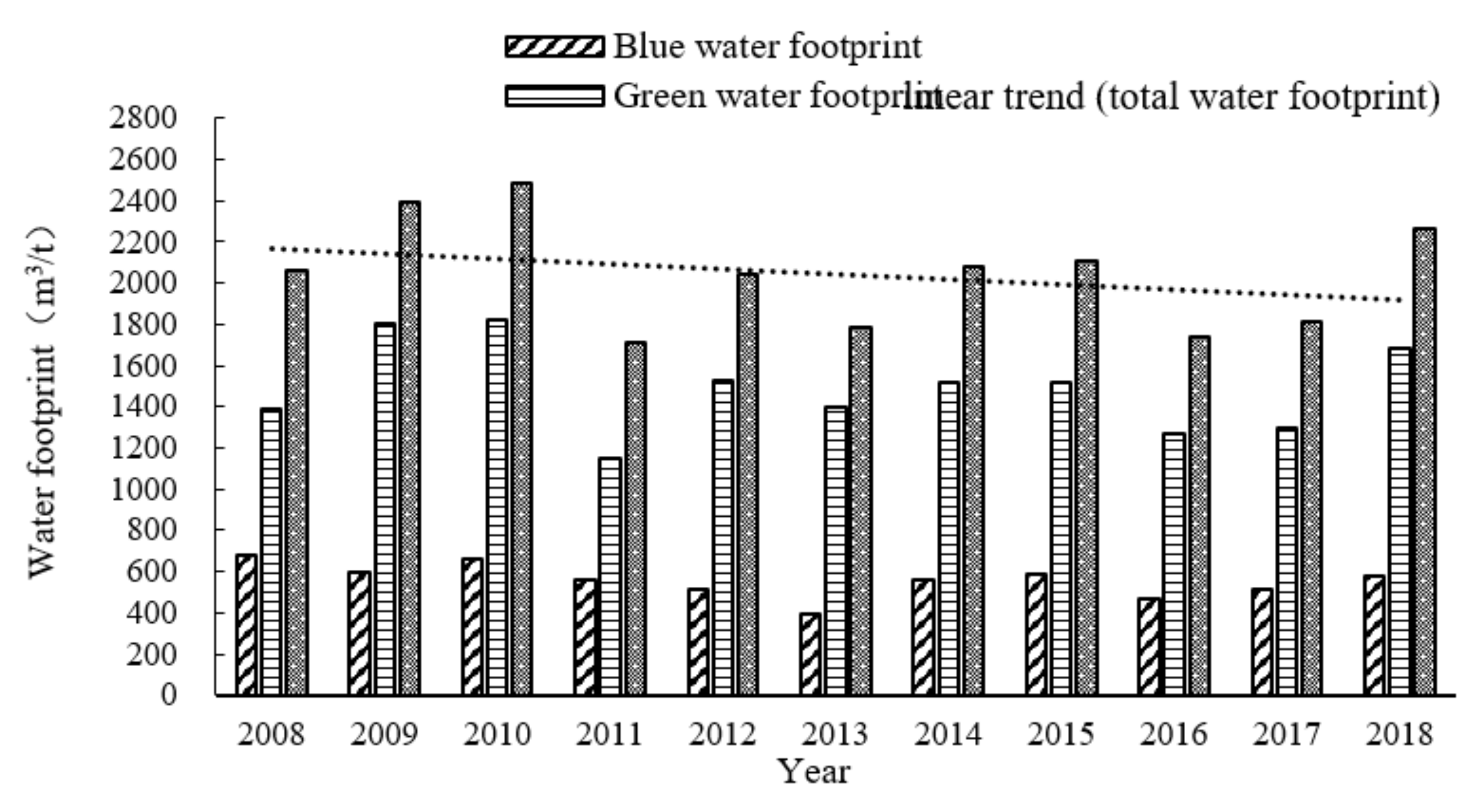




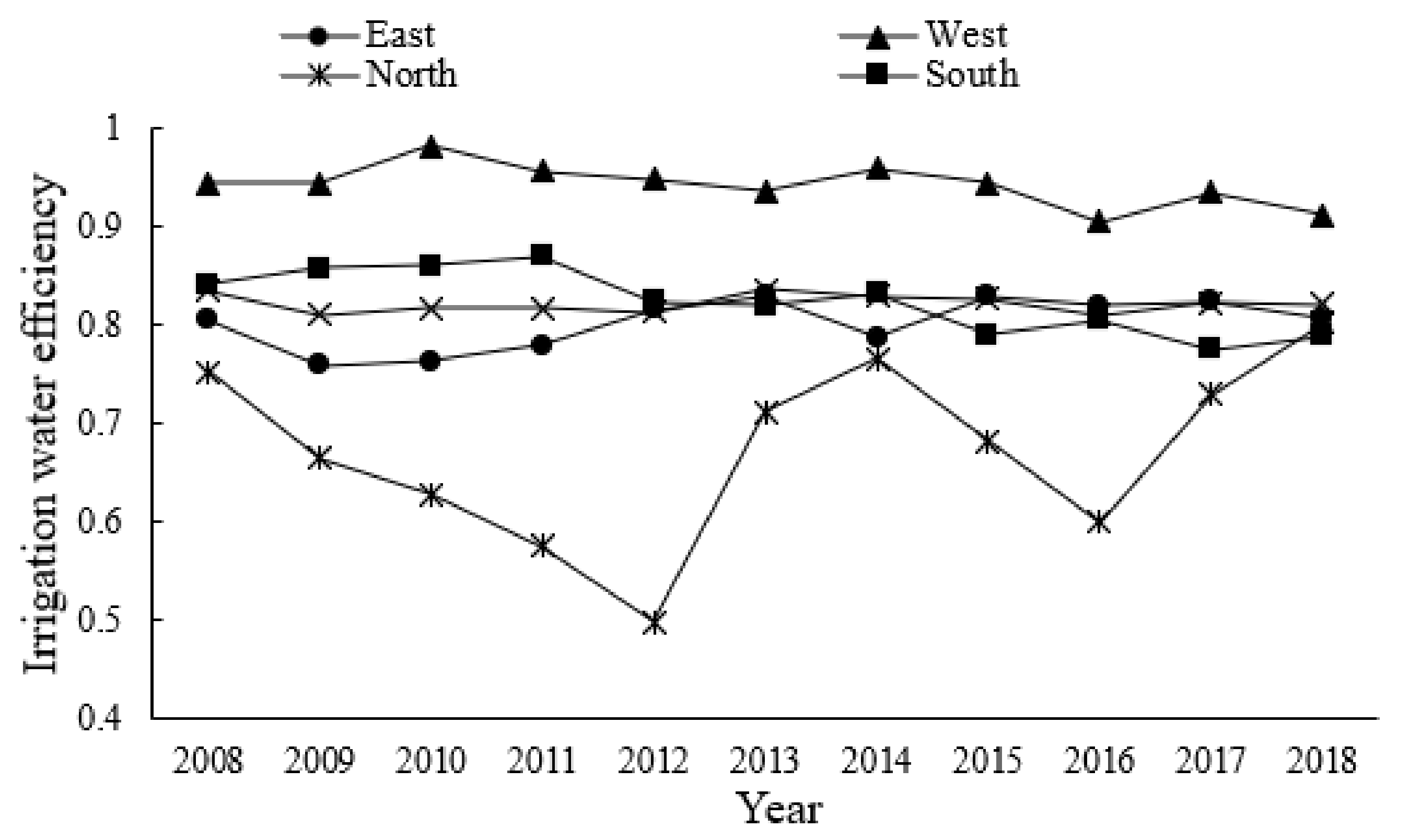
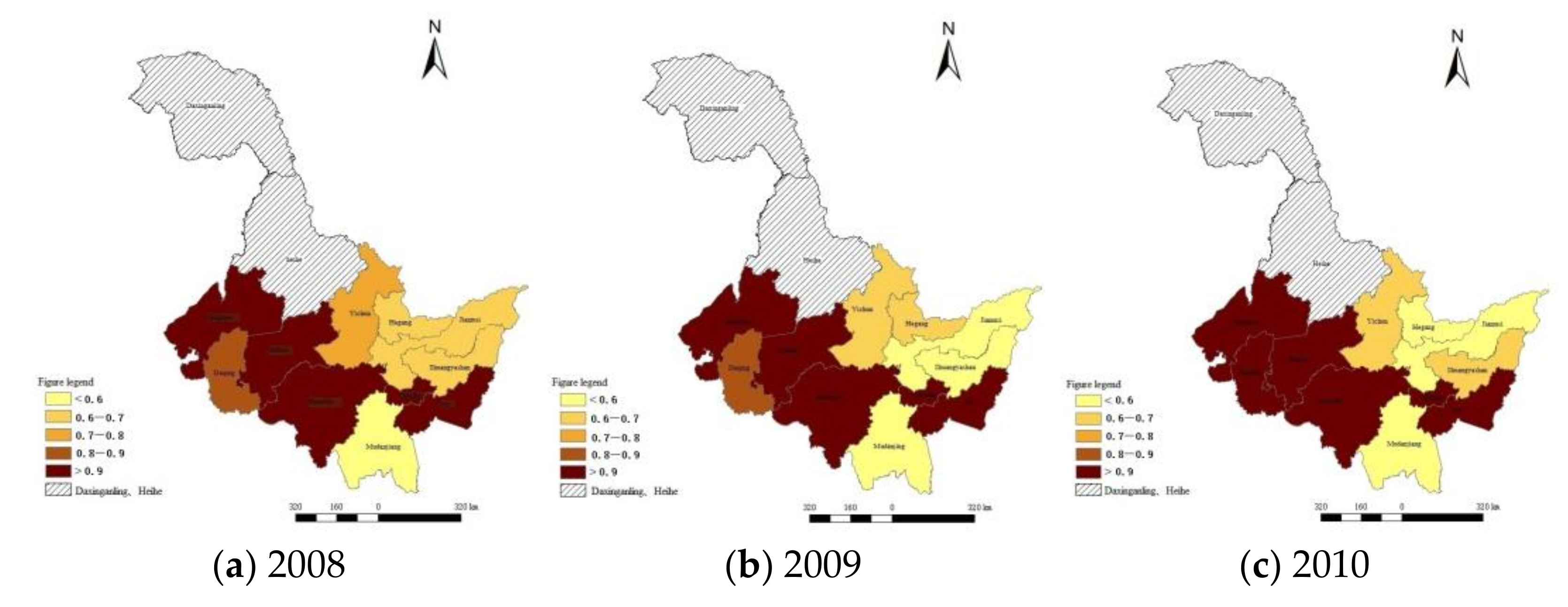
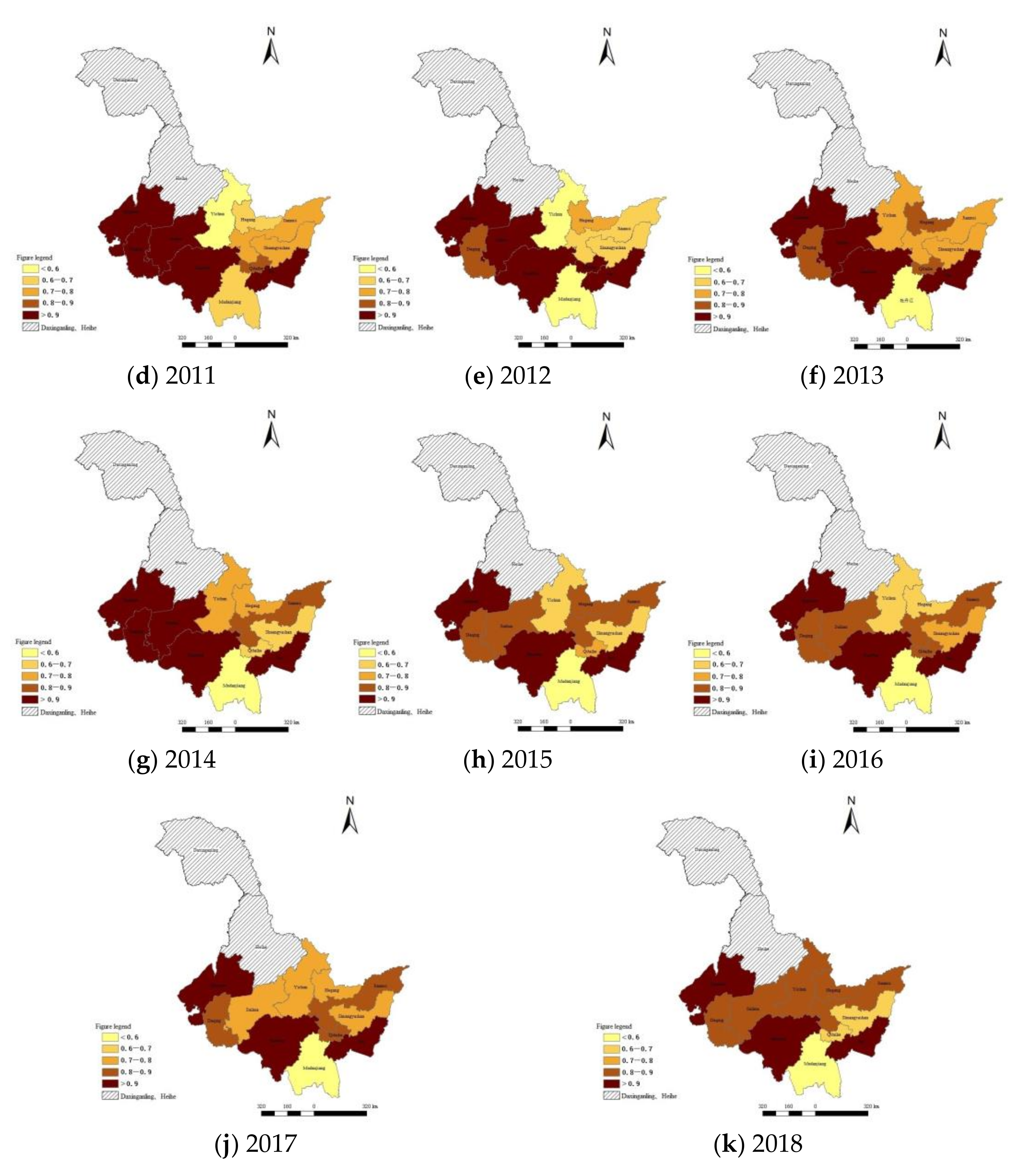
| Indicators | Explanation |
|---|---|
| Grain-sowing area/hm2 | The area actually sown or transplanted with grains throughout the year |
| Total agricultural machinery power/KW | The sum of the rated power of all agricultural machinery |
| Absolute amount of fertilizer/Kg | The converted amount according to 100% nitrogen, phosphorus pentoxide and potassium oxide concentrations |
| Agricultural gross product/Yuan | The total value of all agricultural products expressed in currency and various supporting service activities for the agricultural production activities |
| City | Annual Average Irrigation Water Efficiency | Gap from the Provincial Average/% |
|---|---|---|
| Harbin | 1.000 | 21.73% |
| Qiqihaer | 1.000 | 21.73% |
| Jixi | 1.000 | 21.73% |
| Suihua | 0.937 | 14.10% |
| Daqing | 0.883 | 7.52% |
| Qitaihe | 0.857 | 4.27% |
| Jiamusi | 0.744 | −9.38% |
| Hegang | 0.716 | −12.85% |
| Shuangyashan | 0.691 | −15.89% |
| Yichun | 0.674 | −18.00% |
| Mudanjiang | 0.534 | −34.96% |
| City | SBM TE | CCR TE | PTE | SE |
|---|---|---|---|---|
| Jiamusi | 0.744 | 0.830 | 0.932 | 0.890 |
| Hegang | 0.716 | 0.801 | 0.997 | 0.803 |
| Shuangyashan | 0.691 | 0.940 | 0.993 | 0.946 |
| Yichun | 0.674 | 1.000 | 1.000 | 1.000 |
| Mudanjiang | 0.534 | 0.991 | 0.992 | 0.998 |
| Provincial average level | 0.821 | 0.958 | 0.992 | 0.965 |
Publisher’s Note: MDPI stays neutral with regard to jurisdictional claims in published maps and institutional affiliations. |
© 2022 by the authors. Licensee MDPI, Basel, Switzerland. This article is an open access article distributed under the terms and conditions of the Creative Commons Attribution (CC BY) license (https://creativecommons.org/licenses/by/4.0/).
Share and Cite
Liu, W.; Ma, Z.; Lei, B. Spatiotemporal Distribution of Irrigation Water Use Efficiency from the Perspective of Water Footprints in Heilongjiang Province. Water 2022, 14, 1232. https://doi.org/10.3390/w14081232
Liu W, Ma Z, Lei B. Spatiotemporal Distribution of Irrigation Water Use Efficiency from the Perspective of Water Footprints in Heilongjiang Province. Water. 2022; 14(8):1232. https://doi.org/10.3390/w14081232
Chicago/Turabian StyleLiu, Wei, Ziao Ma, and Bo Lei. 2022. "Spatiotemporal Distribution of Irrigation Water Use Efficiency from the Perspective of Water Footprints in Heilongjiang Province" Water 14, no. 8: 1232. https://doi.org/10.3390/w14081232
APA StyleLiu, W., Ma, Z., & Lei, B. (2022). Spatiotemporal Distribution of Irrigation Water Use Efficiency from the Perspective of Water Footprints in Heilongjiang Province. Water, 14(8), 1232. https://doi.org/10.3390/w14081232





